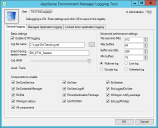Environment Manager
This page refers to an older version of the product.
View the current version of the User Help.
Environment Manager Logging Setup
In this section:
The Environment Manager Logging Setup tool provides a user interface to enable and disable the generation of diagnostic log files.
Administrators or our Support team may need log files to diagnose unexpected Environment Manager behavior, such as Personalization failing for a specific application, or Policy configuration actions not applying as expected.
Environment Manager uses Event Tracing for Windows (ETW) to record log events. Log files are stored in ETL format that can be opened using Environment Manager Monitor.
For information about using Environment Manager Monitor to view and analyze ETL files, see Environment Manager Monitor.
User Interface
Enable or disable logging in the user interface. Use the options to enable logging for specific components or set advanced logging settings.
Enable Logging
- Click the On/Off button located at the top left-hand corner of the dialog to enable logging.
-
Select the General logging tab and modify the settings as required.
Setting Description Enable ETW logging Enable or disable logging on the local endpoint. Log file name The location and name to which the log file is written. Event tracing session name The name for the event tracing session. This name is used in Performance Monitor. Log detail The level of detail that is logged. Unless advised otherwise by Support, it is recommended that the Log detail slider is set to Trace.
Components to enable The components that are logged. File size limit The maximum size of the log file in Mb if Circular Logging or Live Logging is enabled. Max buffers The maximum number of buffers. Buffer size The size of each buffer in Kb. Min buffers The minimum number of buffers. Log File Mode Set the log file mode. The following options are available: - Rollover log - The log file grows to the specified size limit. Once it has reached the limit, a new log file is created with a version number appended to the name.
- Live log - Logging can be viewed in real time using the Environment Manager Monitor. This is the equivalent of Real Time logging in Windows Event Tracing. For more information about opening the live log in the Environment Manager Monitor, see Load Live Logs.
- Circular log - The log file grows to the specified size limit. Once it has reached the limit, the log file automatically overwrites the oldest entries.
- Unlimited log - The log files grows indefinitely regardless of the size limit.
-
Select the Managed Application logging tab and modify the settings as required.
Setting Description Enable PVC logging Enable or disable logging for the PVC (Personalization Virtualization Component). A separate log is generated for each managed process that runs on the endpoint. PVC logging is in text file format. Enable FBR logging Enable or disable logging for the FBR (File Based Registry) files used for Application Personalization. FBR logging is in text file format Enable FBR logging if a file is detected as corrupted Enable or disable logging for the FBR (File Based Registry) files used for Application Personalization if an FBR file is detected as corrupted. Check FBR file for corruption when logging enabled Check FBR files for corruption and attempt to repair the file where possible. Logging must be enabled for this setting to take effect.
Enabling PVC or FBR logging causes a significant increase in system utilization. Unless reproducing a problem or advised otherwise by our Support team, it is recommended that FBR and PVC logging are disabled.
-
Select the Locked down application logging tab and modify the settings as required.
Setting Description Enable Lockdown logging Enable or disable logging for Environment Manager Policy Lockdown activity. Lockdown logging is in text file format. Select which applications are logged: - All applications - Log Lockdown activity for all applications.
- The selected application - Log Lockdown activity for specific applications. Enter one or more executable names in the Application name field. Separate executable names with semicolons.
Enable EmLoader logging Enable or disable logging for the injection of the EmLoader component. EmLoader logging is in text file format EmLoader and Lockdown log directory The location and name to which the EmLoader and Lockdown log files are written. Enabling EmUser or Lockdown logging causes a significant increase in system utilization. Unless reproducing a problem or advised otherwise by Support, it is recommended that EmUser and Lockdown logging are disabled.
- Click OK
- A confirmatory dialog displays.
- Click OK to confirm.
A log file is created in the specified location and logging is enabled on the endpoint. A reboot or agent restart is not required for the change to take effect.
Disable Logging
-
Click the On/Off button located at the top left-hand corner of the dialog to disable logging.
-
Click OK.
A confirmatory dialog displays.
-
Click OK to confirm.
Logging is disabled on the endpoint. A reboot or agent restart is not required for the change to take effect.
